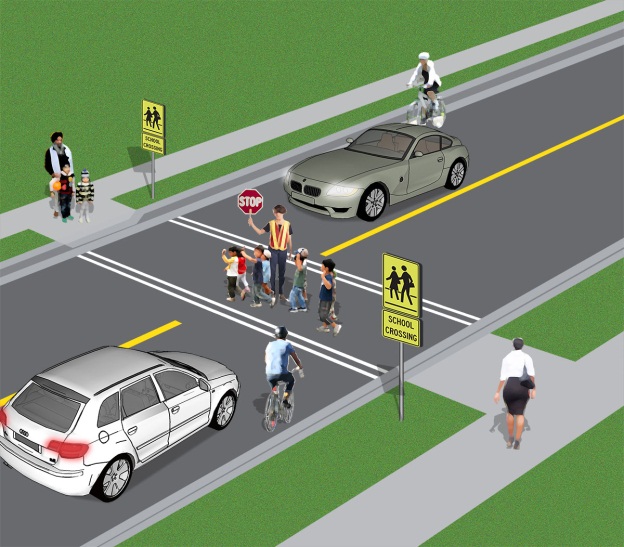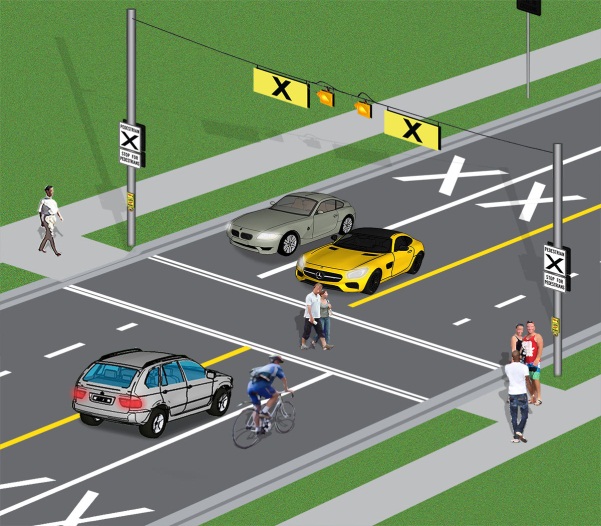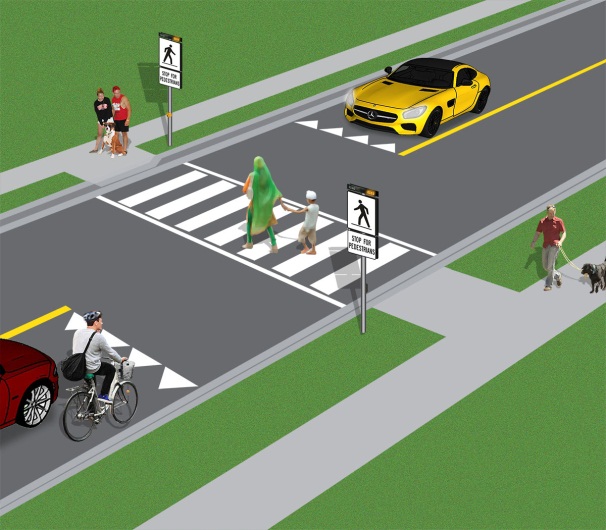It is up to both drivers and pedestrians to keep everyone safe on Ontario roads. Learn the rules for pedestrian crossings, the penalties for endangering pedestrians and get tips for driving and walking safely.
- Driving laws for pedestrian crossovers and school crossings
- Penalties for endangering pedestrians
- Tips for pedestrians
- Tips for drivers
- Tips for parents
Driving laws for pedestrian crossovers and school crossings
Drivers - including cyclists - must stop and yield the whole roadway at pedestrian crossovers, school crossings and other locations where there is a crossing guard. Only when pedestrians and school crossing guards have crossed and are safely on the sidewalk can drivers and cyclists proceed.
A school crossing is any pedestrian crossing where a school crossing guard is present and displaying a school crossing stop sign.

Pedestrian crossovers are identified by specific signs, pavement markings and lights. Some have illuminated overhead lights/warning signs and pedestrian push buttons. There are four types of pedestrian crossovers in Ontario.




This law does not apply to pedestrian crosswalks at intersections with stop signs or traffic signals, unless a school crossing guard is present.
A crosswalk is a crossing location usually found at intersections with traffic signals, pedestrian signals or stop signs. A crosswalk can be:
- the portion of a roadway that connects sidewalks on opposite sides of the roadway into a continuous path; or,
- the portion of a roadway that is indicated for pedestrian crossing by signs, lines or other markings on the surface of the roadway at any location, including an intersection.

Penalties for drivers who endanger pedestrians
Penalties for drivers who endanger pedestrians increased September 1, 2018. This includes higher fines and more demerit points for drivers who fail to yield to pedestrians at crossovers, school crossings and crosswalks with a school crossing guard present, as well as new penalties for drivers who are convicted of careless driving causing death or bodily harm.
Offence |
Fine* |
Demerits |
Other Penalties |
|---|---|---|---|
| Failing to yield at pedestrian crosswalks, school crossings, and crossovers |
Up to $1000 |
Four demerit points |
N/A |
| Running a red light | Up to $1000 | Three demerit points | N/A |
| Failure to stop for a school bus |
First offence: Each following offence: |
Six demerit points | May result in imprisonment for up to six months |
| Failure to remain at scene of collision | Up to $2000 | Seven demerit points | May result in imprisonment for up to six months and/or a two-year driver’s licence suspension |
| *Fines are doubled in Community Safety Zones— near schools and public areas. These areas are clearly marked with signs. | |||
In addition to the penalties above, aggressive or careless drivers who put themselves and other road users, such as pedestrians, at risk may be charged with careless driving. If you are convicted of careless driving you can face:
- Fines of up to $2,000
- Six demerit points
- A maximum of six months in jail
- A driver’s licence suspension of up to two years
As of September 1, 2018, if you are convicted of careless driving causing bodily harm or death you can face:
- Fines from $2,000 to $50,000
- Six demerit points
- A maximum of two years in jail
- Courts can impose a driver’s licence suspension of up to five years
For information on these offences, you can visit MTO’s website or search for these offences in the Highway Traffic Act.
Safety Tips for Pedestrians
- Cross only at marked crosswalks or crossovers. Don't cross in the middle of the block or between parked cars.
- Make sure drivers see you before you cross. If the driver is stopped, make eye contact before you step into the road.
- Wear bright or light-coloured clothing or reflective wear, especially at dusk or when it's dark.
- At a traffic light:
- Cross when traffic has come to a complete stop.
- Begin to cross at the start of the green light or “Walk” signal, where provided.
- Do not start to cross if you see a flashing “Do Not Walk” symbol or the light turns yellow. If you already started to cross, complete your crossing in safety.
- Never cross on a red light.
- Watch for traffic turning at intersections or turning into and leaving driveways.
Safety Tips for Drivers
Pay special attention to pedestrians as you drive. Here are some tips to follow:
- Always look for pedestrians, especially when turning.
- Watch for children. Drive slowly and cautiously through school zones, residential areas, or any other area where children could be walking or playing.
- Watch out for Community Safety Zone signs that indicate areas where public safety is a special concern, including the possibility of encountering pedestrians.
- Be patient, especially with seniors or pedestrians with disabilities who need more time to cross the road.
- Drive carefully near streetcar stops with islands or zones for passengers getting on and off. Pass them at reasonable speeds, and always be ready in case pedestrians make sudden or unexpected moves.
Safety Tips for Parents
Show your children how to cross a road safely. Teach them to:
- Stay to the side of the road, walking as far away from traffic as they safely can
- Stop at the edge of the sidewalk, and look both ways before crossing the road
- Take extra care on roadways that have no curbs
- Watch out for blind corners (for example, a car coming out of an alley may not see a child pedestrian about to cross).